Architecture
关于建筑的英语作文

Architecture is a fascinating field that combines art,science,and engineering to create functional and aesthetically pleasing structures.Here are some key points to consider when writing an essay about architecture:1.Historical Context:Start by discussing the historical development of architecture. Mention the different architectural styles that have emerged over time,such as Gothic, Renaissance,Baroque,Modernism,and Postmodernism.2.Cultural Influences:Explore how architecture is influenced by culture.Discuss how different societies and civilizations have unique architectural styles that reflect their values,beliefs,and ways of life.3.Materials and Techniques:Describe the various materials used in construction,such as stone,wood,concrete,and steel,and the techniques employed to create different architectural forms.4.Famous Architects:Mention some of the most influential architects in history,such as Frank Lloyd Wright,Le Corbusier,Zaha Hadid,and I.M.Pei,and discuss their contributions to the field.5.Sustainable Architecture:Address the importance of sustainable architecture in the modern world.Discuss how architects are incorporating ecofriendly materials and designs to reduce the environmental impact of buildings.6.Function and Form:Explain the balance between the functionality and aesthetic appeal of a building.Discuss how architects must consider the purpose of the structure and the needs of its users while also creating visually appealing designs.7.Innovation and Technology:Highlight the role of technology in modern architecture. Discuss how digital tools and software are used in the design process,and how advancements in construction technology are pushing the boundaries of what is possible in building design.8.Urban Planning and Architecture:Talk about the relationship between architecture and urban planning.Explain how architects work with urban planners to create cohesive and functional cityscapes.9.Case Studies:Include specific examples of buildings or architectural projects to illustrate your points.Analyze the design,purpose,and impact of these structures.10.Personal Reflection:Conclude your essay with a personal reflection on the importance of architecture in society.Discuss why you find the field interesting and what you hope to see in the future of architectural design.Remember to use clear and concise language,provide specific examples,and cite any sources you reference.An essay on architecture should not only inform but also inspire readers to appreciate the art and science of building design.。
architecture的名词和形容词
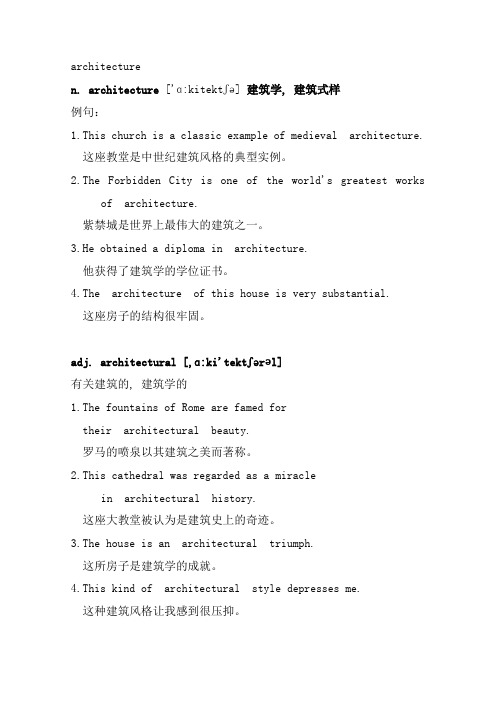
architecture
n. architecture ['ɑ:kitektʃә] 建筑学, 建筑式样
例句:
1.T his church is a classic example of medieval architecture.
这座教堂是中世纪建筑风格的典型实例。
2.T he Forbidden City is one of the world's greatest works
of architecture.
紫禁城是世界上最伟大的建筑之一。
3.H e obtained a diploma in architecture.
他获得了建筑学的学位证书。
4.T he architecture of this house is very substantial.
这座房子的结构很牢固。
adj. architectural [,ɑ:ki'tektʃәrәl]
有关建筑的, 建筑学的
1.T he fountains of Rome are famed for
their architectural beauty.
罗马的喷泉以其建筑之美而著称。
2.T his cathedral was regarded as a miracle
in architectural history.
这座大教堂被认为是建筑史上的奇迹。
3.T he house is an architectural triumph.
这所房子是建筑学的成就。
4.T his kind of architectural style depresses me.
这种建筑风格让我感到很压抑。
《英语建筑介绍》课件

The uppermost part of a building that protects it from the elements.
Building Materials
Concrete Steel Wood
Strong and versatile, concrete is commonly used in construction.
Career Opportunities in Architecture
Architect
Designing and planning buildings, coordinating with clients and contractors.
Interior Designer
Creating functional and aesthetically pleasing interior spor public spaces such as government buildings, museums, and educational institutions.
Different Styles of Architecture
Traditional Chinese Architecture
Characteristics
Neoclassical architecture draws inspiration from classical Greek and Roman designs, with symmetrical facades, columns, and pediments.
Famous Examples
Urban Planner
Developing strategies to shape the growth and development of cities and communities.
Coach与Bus,Building与Architecture
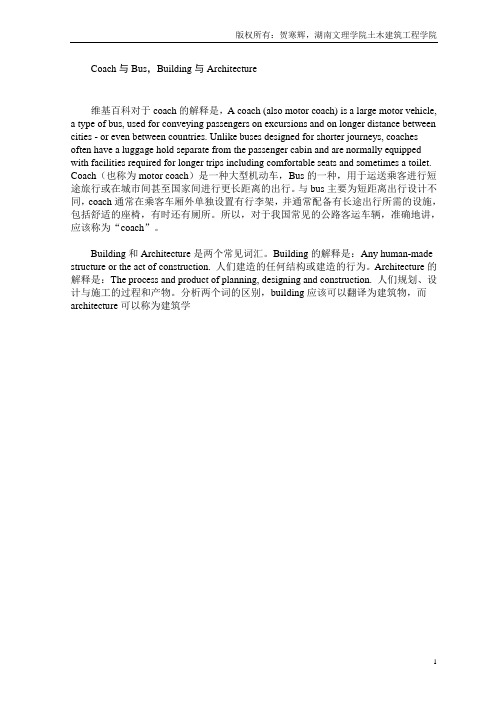
版权所有:贺寒辉,湖南文理学院土木建筑工程学院Coach与Bus,Building与Architecture维基百科对于coach的解释是,A coach (also motor coach) is a large motor vehicle, a type of bus, used for conveying passengers on excursions and on longer distance between cities - or even between countries. Unlike buses designed for shorter journeys, coaches often have a luggage hold separate from the passenger cabin and are normally equipped with facilities required for longer trips including comfortable seats and sometimes a toilet. Coach(也称为motor coach)是一种大型机动车,Bus的一种,用于运送乘客进行短途旅行或在城市间甚至国家间进行更长距离的出行。
与bus主要为短距离出行设计不同,coach通常在乘客车厢外单独设置有行李架,并通常配备有长途出行所需的设施,包括舒适的座椅,有时还有厕所。
所以,对于我国常见的公路客运车辆,准确地讲,应该称为“coach”。
Building和Architecture是两个常见词汇。
Building的解释是:Any human-made structure or the act of construction. 人们建造的任何结构或建造的行为。
Architecture的解释是:The process and product of planning, designing and construction. 人们规划、设计与施工的过程和产物。
architecture的形容词
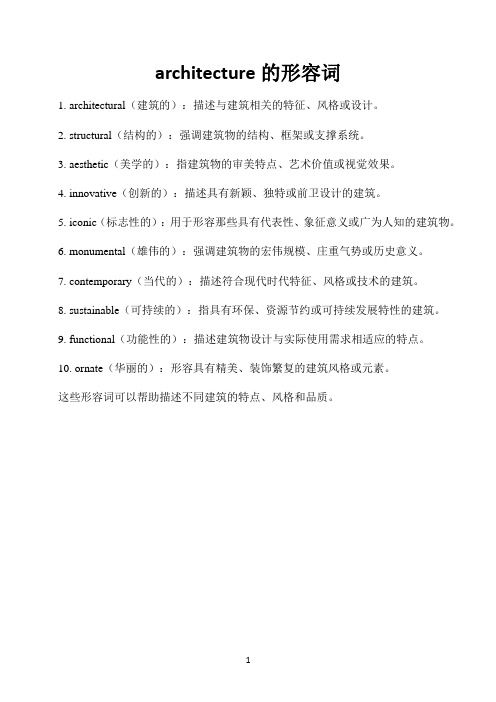
architecture的形容词
1. architectural(建筑的):描述与建筑相关的特征、风格或设计。
2. structural(结构的):强调建筑物的结构、框架或支撑系统。
3. aesthetic(美学的):指建筑物的审美特点、艺术价值或视觉效果。
4. innovative(创新的):描述具有新颖、独特或前卫设计的建筑。
5. iconic(标志性的):用于形容那些具有代表性、象征意义或广为人知的建筑物。
6. monumental(雄伟的):强调建筑物的宏伟规模、庄重气势或历史意义。
7. contemporary(当代的):描述符合现代时代特征、风格或技术的建筑。
8. sustainable(可持续的):指具有环保、资源节约或可持续发展特性的建筑。
9. functional(功能性的):描述建筑物设计与实际使用需求相适应的特点。
10. ornate(华丽的):形容具有精美、装饰繁复的建筑风格或元素。
这些形容词可以帮助描述不同建筑的特点、风格和品质。
1。
建筑的英语知识点总结

建筑的英语知识点总结IntroductionArchitecture is the art and science of designing and constructing buildings and other physical structures. It is a field that requires a comprehensive understanding of various disciplines, including engineering, design, art, and social sciences. The practice of architecture involves creating functional and aesthetically pleasing spaces that meet the needs of the people who use them.In this article, we will discuss key knowledge points in architecture, including architectural history, design principles, construction techniques, and sustainable architecture. Architectural HistoryArchitecture has a rich history that dates back to ancient civilizations. Some of the earliest known architectural structures can be traced back to the ancient Mesopotamian, Egyptian, Greek, and Roman civilizations. These early architectural marvels include the pyramids of Egypt, the Parthenon in Greece, and the Colosseum in Rome.Throughout history, architecture has evolved and been shaped by various cultural, technological, and political influences. Different architectural styles have emerged in different periods and regions, including Gothic, Renaissance, Baroque, Rococo, Neoclassical, and Modernism, to name a few.Architectural history provides valuable insights into the development of architectural styles, construction techniques, and the role of architecture in shaping societies and cultures. It also serves as a source of inspiration and reference for contemporary architects and designers.Design PrinciplesArchitectural design is guided by a set of principles that govern the creation of buildings and spaces. These design principles include:1. Function: Architecture should be designed to meet the functional needs of the people who use the space. This includes considerations for activities, circulation, and spatial organization.2. Form: The form of a building should be aesthetically pleasing and harmonious with its surroundings. This involves the use of proportion, scale, and symmetry to create visually appealing structures.3. Structure: The structural system of a building is essential in providing stability, support, and safety. Different structural systems, such as post-and-beam, load-bearing, and frame construction, are used to accommodate different architectural designs.4. Materials: The selection of materials in architecture affects the durability, appearance, and environmental impact of a building. Common building materials include concrete, steel, wood, glass, and masonry.5. Context: Architecture should respond to its physical, cultural, and historical context. This involves considering the site, climate, local traditions, and social dynamics in the design process.6. Sustainability: Sustainable design principles promote the use of environmentally friendly materials, energy-efficient systems, and green building practices. This includes considerations for energy consumption, water conservation, and waste reduction.Construction TechniquesArchitectural construction involves the process of building physical structures based on architectural designs. Construction techniques have evolved over time and continue to be influenced by advancements in technology, materials, and building methods. Some key construction techniques in architecture include:1. Traditional construction: Traditional construction methods, such as masonry, timber framing, and adobe construction, have been used for centuries to build durable and functional structures.2. Modern construction: Modern construction techniques involve the use of advanced materials, equipment, and processes to achieve efficient and high-quality construction. This includes the use of steel, concrete, precast elements, and modular construction.3. Sustainable construction: Sustainable construction techniques focus on reducing the environmental impact of buildings through green building practices, energy-efficient systems, and renewable materials.4. Building systems: Building systems, such as structural, mechanical, electrical, and plumbing systems, are essential in providing the functionality and comfort of a building. These systems are integrated into the architectural design to ensure a seamless and efficient building operation.5. Construction management: Construction management involves the planning, coordination, and supervision of construction projects to ensure that they are completed on time, within budget, and to the desired quality standards.Sustainable ArchitectureSustainable architecture, also known as green architecture or eco-friendly architecture, promotes environmentally conscious design and construction practices. It aims to minimize the environmental impact of buildings while creating healthy and efficient spaces for the occupants. Key principles of sustainable architecture include:1. Energy efficiency: Sustainable buildings are designed to consume less energy through the use of passive design strategies, energy-efficient systems, and renewable energy sources.2. Water conservation: Sustainable buildings incorporate water-efficient fixtures, rainwater harvesting systems, and greywater recycling to reduce water consumption and promote water stewardship.3. Material selection: Sustainable architecture emphasizes the use of environmentally friendly materials, such as recycled, low-impact, and renewable materials, to minimize resource depletion and waste generation.4. Indoor environmental quality: Sustainable buildings prioritize indoor air quality, natural ventilation, daylighting, and thermal comfort to create healthy and comfortable living and working environments.5. Site planning: Sustainable architecture considers the site's ecological and social context, promoting site preservation, biodiversity, and community connectivity.6. Life cycle assessment: Sustainable design takes into account the life cycle impact of buildings, from materials extraction and manufacturing to construction, operation, and end-of-life disposal.ConclusionArchitecture is a multidisciplinary field that encompasses a wide range of knowledge points, including architectural history, design principles, construction techniques, and sustainable architecture. Understanding these knowledge points is essential for architects, designers, builders, and other professionals involved in the planning, design, and construction of buildings and spaces. As the field of architecture continues to evolve, it is important to stay informed about the latest developments, trends, and best practices in architecture to create a built environment that is functional, aesthetically pleasing, and sustainable for future generations.。
Architecture-建筑艺术
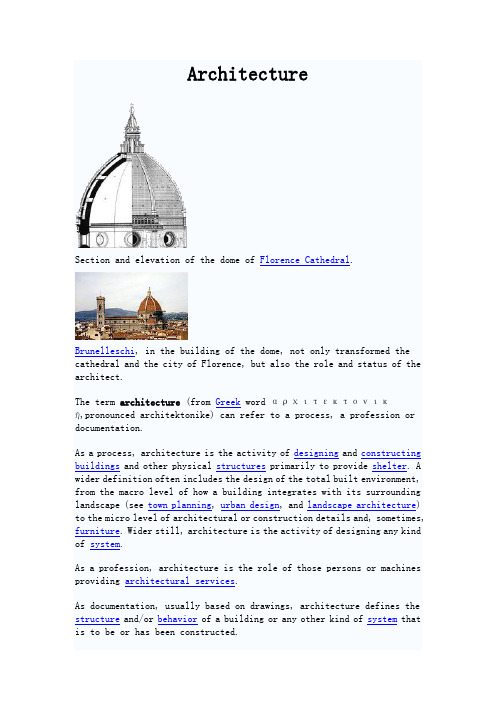
∙Durability - it should stand up robustly and remain in good condition.∙Utility - it should be useful and function well for the people using it.∙Beauty - it should delight people and raise their spirits.Leone Battista Alberti, who elaborates on the ideas of Vitruvius in his treatise, De Re Aedificatoria, saw beauty primarily as a matter of proportion, although ornament also played a part. For Alberti, the rules of proportion were those that governed the idealised human figure, the Golden Mean. The most important aspect of beauty was therefore an inherent part of an object, rather than something applied superficially; and was based on universal, recognisable truths. The notion of style in the arts was not developed until the 16th century, with the writing of Vasari.[14] The treatises, by the 18th century, had been translated into Italian, French, Spanish and English.In the early nineteenth century, Augustus Welby Northmore Pugin wrote Contrasts (1836) that, as the titled suggested, contrasted the modern, industrial world, which he disparaged, with an idealized image ofneo-medieval world. Gothic architecture, Pugin believed, was the only “true Christian form of architecture.”The 19th century English art critic, John Ruskin, in his Seven Lamps of Architecture, published 1849,[15] was much narrower in his view of what constituted architecture. Architecture was the "art which so disposes and adorns the edifices raised by men ... that the sight of them" contributes "to his mental health, power, and pleasure". For Ruskin, the aesthetic was of overriding significance. His work goes on to state that a building is not truly a work of architecture unless it is in some way "adorned". For Ruskin, a well-constructed, well-proportioned, functional building needed string courses or rustication, at the very least.On the difference between the ideals of "architecture" and mere "construction", the renowned 20th C. architect Le Corbusier wrote: "You employ stone, wood, and concrete, and with these materials you build houses and palaces: that is construction. Ingenuity is at work. But suddenly you touch my heart, you do me good. I am happy and I say: This is beautiful. That is Architecture".[16]The National Congress of Brazil, designed by Oscar Niemeyer.Modern concepts of architectureThe great 19th century architect of skyscrapers, Louis Sullivan, promoted an overriding precept to architectural design: "Form follows function".While the notion that structural and aesthetic considerations should be entirely subject to functionality was met with both popularity and skepticism, it had the effect of introducing the concept of "function" in place of Vitruvius "utility". "Function" came to be seen as encompassing all criteria of the use, perception and enjoyment of a building, not only practical but also aesthetic, psychological and cultural.Sydney Opera House, designed by Utzon.Nunzia Rondanini stated, "Through its aesthetic dimension architecture goes beyond the functional aspects that it has in common with other human sciences. Through its own particular way of expressing values, architecture can stimulate and influence social life without presuming that, in and of itself, it will promote social development.To restrict the meaning of (architectural) formalism to art for art's sake is not only reactionary; it can also be a purposeless quest for perfection or originality which degrades form into a mere instrumentality".[17]Among the philosophies that have influenced modern architects and their approach to building design are rationalism, empiricism, structuralism, poststructuralism, and phenomenology.In the late 20th century a new concept was added to those included in the compass of both structure and function, the consideration of sustainability. To satisfy the modern ethos a building should be constructed in a manner which is environmentally friendly in terms of the production of its materials, its impact upon the natural and built environment of its surrounding area and the demands that it makes upon non-sustainable power sources for heating, cooling, water and waste management and lighting.Historyempirical ones and new building types emerged. Architectural styles developed.Texts on architecture began to be written in the Classical period. These became canons to be followed in important works, especially religious architecture. Some examples of canons are found in the writings of Vitruvius , the Kao Gong Ji of ancient China [18] and Vaastu Shastra of ancient India .The architecture of different parts of Asia developed along different lines to that of Europe, Buddhist, Hinduand Sikh architecture each having different characteristics. Buddhist architecture, in particular, showed great regional diversity. In many Asian countries a pantheistic religion led to architectural forms that were designed specifically to enhance the natural landscape .The Medieval builderThis section does not cite any references or sources . Please help improve this article by adding citations to reliable sources . Unverifiable material may be challenged and removed. (July 2008)Wells Cathedral, Somerset, England.In Europe, in both the Classical and Medieval periods, buildings were not attributed to specific individuals and the names of the architects frequently unknown, despite the vast scale of the many religious buildings extant from this period. During the Medieval period guilds were formed by craftsmen to organise their trade and written contracts have survived, particularly in relation to ecclesiastical buildings. The role of architect was usually one with master builder, except in the case where a cleric, such as the Abbot Suger at Saint Denis, Paris, provided the design. Over time the complexity of buildings and their types increased. General civil construction such as roads and bridges began to be built. Many new building types such as schools, hospitals, and recreational facilities emerged.Renaissance and the architectThis section does not cite any references or sources. Please help improve this article by adding citations to reliable sources.Unverifiable material may be challenged and removed. (July 2008)St Pancras Midland Hotel, London There was also the rise of the "gentleman architect" who usually dealt with wealthy clients and concentrated predominantly on visual qualities derived usually from historical prototypes, typified by the many country houses of Great Britain that were created in the Neo Gothic or Scottish Baronial styles.Formal architectural training, inthe 19th century, at, for example Ecole des Beaux Arts in France , gave much emphasis to the production of beautiful drawings and little to context and feasibility. Effective architects generally received their training in the offices of other architects, graduating to the role from draughtsmen or clerks.Meanwhile, the Industrial Revolution laid open the door for massproduction and consumption. Aesthetics became a criterion for the middle class as ornamented products, once within the province of expensive craftsmanship, became cheaper under machine production. Vernacular architecture became increasingly ornamental. House builders could use current architectural design in their work by combining features found in pattern books and architectural journals.Modernism and reaction of architectureThis section does not cite any references or sources . Please help improve this article by adding citations to reliable sources . Unverifiable material may be challenged and removed. (July 2008)The dissatisfaction with such a general situation at the turn of the twentieth century gave rise to many new lines of thought that served as precursors to Modern Architecture. Notable among these is the Deutscher Werkbund, formed in 1907 to produce better quality machine made objects. The rise of the profession of industrial design is usually placed here.Following this lead, the Bauhaus school, founded in Germany in 1919, consciously rejected history and looked at architecture as a synthesis of art, craft, and technology.When Modern architecture was first practiced, it was an avant-garde movement with moral, philosophical, and aesthetic underpinnings. Immediately after World War I, pioneering modernist architects sought to develop a completely new style appropriate for a new post-war social and economic order, focused on meeting the needs of the middle and working classes. They rejected the architectural practice of the academic refinement of historical styles which served the rapidly declining aristocratic order.Fallingwater by Frank Lloyd Wright.The approach of the Modernist architects was to reduce buildings to pure forms, removing historical references and ornament in favor of functionalist details. Buildings that displayed their construction and structure, exposing steel beams and concrete surfaces instead of hiding them behind traditional forms, were seen as beautiful in their own right. Architects such as Mies van der Rohe worked to create beauty based on the inherent qualities of building materials and modern construction techniques, trading traditional historic forms for simplified geometric forms, celebrating the new means and methods made possible by the Industrial Revolution.Many architects resisted Modernism, finding it devoid of the decorative richness of ornamented styles. As the founders of the International Style lost influence in the late 1970s, Postmodernism developed as a reaction against the austerity of Modernism. Robert Venturi's contention that a "decorated shed" (an ordinary building which is functionally designed inside and embellished on the outside) was better than a "duck" (a buildingin which the whole form and its function are tied together) gives an idea of this approach.Architecture todayMain article: Contemporary architecturePostmodern design at Gare do Oriente, Lisbon, by Santiago Calatrava.Part of the architectural profession, and also some non-architects, responded to Modernism and Postmodernism by going to what they considered the root of the problem. They felt that architecture was not a personal philosophical or aesthetic pursuit by individualists; rather it had to consider everyday needs of people and use technology to give a livable environment. The Design Methodology Movement involving people such as Christopher Alexander started searching for more people-oriented designs. Extensive studies on areas such as behavioral, environmental, and social sciences were done and started informing the design process.As the complexity of buildings began to increase (in terms of structural systems, services, energy and technologies), architecture started becoming more multi-disciplinary. Architecture today usually requires a team of specialist professionals, with the architect being one of many, although usually the team leader.During the last two decades of the twentieth century and into the new millennium, the field of architecture saw the rise of specializations by project type, technological expertise or project delivery methods. In addition, there has been an increased separation of the 'design' architect [a] from the 'project' architect.[b]Moving the issues of environmental sustainability into the mainstream is a significant development in the architecture profession. Sustainability in architecture was pioneered in the 1970s by architects such as Ian McHarg in the US and Brenda and Robert Vale in the UK and New Zealand. There has been an acceleration in the number of buildings which seek to meet green building sustainable design principles. It is now expected that architects will integrate sustainable principles into their projects.[19]。
建筑学英语
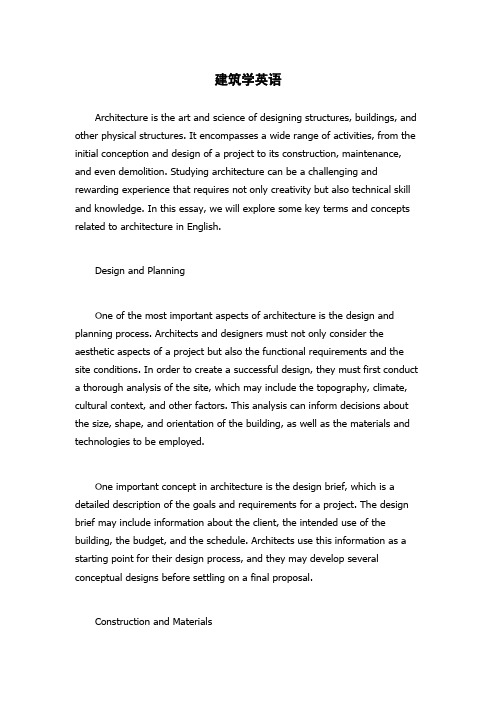
建筑学英语Architecture is the art and science of designing structures, buildings, and other physical structures. It encompasses a wide range of activities, from the initial conception and design of a project to its construction, maintenance, and even demolition. Studying architecture can be a challenging and rewarding experience that requires not only creativity but also technical skill and knowledge. In this essay, we will explore some key terms and concepts related to architecture in English.Design and PlanningOne of the most important aspects of architecture is the design and planning process. Architects and designers must not only consider the aesthetic aspects of a project but also the functional requirements and the site conditions. In order to create a successful design, they must first conduct a thorough analysis of the site, which may include the topography, climate, cultural context, and other factors. This analysis can inform decisions about the size, shape, and orientation of the building, as well as the materials and technologies to be employed.One important concept in architecture is the design brief, which is a detailed description of the goals and requirements for a project. The design brief may include information about the client, the intended use of the building, the budget, and the schedule. Architects use this information as a starting point for their design process, and they may develop several conceptual designs before settling on a final proposal.Construction and MaterialsOnce the design is finalized, the construction process can begin. This involves a range of activities, including site preparation, foundation work, framing, and finishing. In order to ensure that the project is completed on time and on budget, architects and builders must closely manage the construction process and oversee the work of subcontractors and other workers.A key consideration in construction is the selection of materials. Architects must choose materials that are both durable and aesthetically pleasing, and that are appropriate for the site conditions and the intended use of the building. Common construction materials include wood, concrete, steel, and glass, among others. Architects must also consider the environmental impact of the materials they select, and may choose to use sustainable or recycled materials whenever possible.Styles and MovementsArchitecture has a long and rich history, and there are many different styles and movements that have emerged over the centuries. Some of the most notable styles and movements include:Classical architecture: This style was popularized in ancient Greece and Rome, and is characterized by its use of columns, domes, and other classical forms.Gothic architecture: This style emerged in medieval Europe and is characterized by its use of pointed arches, ribbed vaults, and soaring, vertical spaces.Modernism: This movement emerged in the early 20th century and is characterized by its use of clean lines, simple forms, and an emphasis on functionality.Postmodernism: This movement emerged in the late 20th century and is characterized by its use of historical references, playful forms, and an emphasis on cultural context.ConclusionIn conclusion, architecture is a complex and multifaceted field that requires a deep understanding of design, construction, materials, and history. Studying architecture can be both challenging and rewarding, and can lead to a wide range of career opportunities in architecture firms, construction companies, and government agencies. Whether you are interested in classical, Gothic, modernist, or postmodernist architecture, there is a wealth of information and inspiration to be found in the English language.。
建筑设计英语词汇ARCHITECTUREDESIGNEnglishChinese

TABLE OF CONTENTS 1. ARCHITECTURE 建筑专业建筑专业a. DESIGN BASIS 设计依据设计依据设计依据b. DESIGN STAGE 设计阶段设计阶段c. CLIMATE CONDITION 气象条件气象条件d. GENERAL ROOM NAME常用房间名称常用房间名称e. ROOFING & CEILING ROOFING & CEILING f. WALL (CLADDING) 墙体(外墙板) g. FLOOR & TRENCH 地面及地沟地面及地沟h. DOORS 、GLASS、WINDOWS & IRONMONGERY (HARDWARE) 门、玻璃、窗及五金件门、玻璃、窗及五金件门、玻璃、窗及五金件i. STAIRCASE、LANDING & LIFT (ELEV A TOR) 楼梯、休息平台及电梯楼梯、休息平台及电梯j. BUILDING MA TERIAL WORDS AND PHRASES 建筑材料词汇及短语建筑材料词汇及短语砖和瓦】【 Bricks and Tiles 砖和瓦】灰、砂和石】【Lime, Sand and Stone 灰、砂和石】水泥、砂浆和混凝土】【Cement, Mortar and Concrete 水泥、砂浆和混凝土】饰面及粉刷材料】【Facing And Plastering Materials 饰面及粉刷材料】沥青和石棉】【Asphalt (Bitumen) and Asbestos 沥青和石棉】木材】【Timber 木材】金属材料】【Metallic Materials 金属材料】有色金属】【Non-Ferrous Metal 有色金属】防腐蚀材料】【Anti-Corrosion Materials防腐蚀材料】建筑五金】【Building Hardware 建筑五金】油漆】【Paint 油漆】k. OTHER ARCHITECTURAL TERMS 其它建筑术语其它建筑术语专业】【Discipline 专业】一般通用名词】【Conventional Terms 一般通用名词】建筑物理】【Architectural Physics 建筑物理】职务名称】【Name Of Professional role 职务名称】制图】【Drafting 制图】2. STRUCTURE 结构专业结构专业a. LOAD 荷载荷载b. GROUND BASE AND FOUNDATION 地基及基础地基及基础c. REINFORCEMENT CONCRETE STRUCTURE 钢筋混凝土结构钢筋混凝土结构d. STEEL STRUCTURE 钢结构钢结构钢结构 e. DESIGN FOR ANTISEISMIC 抗震设计抗震设计f. GENERAL WORDS FOR DESIGN 设计常用词汇设计常用词汇g. GENERAL WORDS FOR CONSTRUCTION 施工常用词汇施工常用词汇1. ARCHITECTURE 建筑专业建筑专业a. DESIGN BASIS 设计依据设计依据设计依据 计划建议书planning planning proposalsproposals 设计任务书design design orderorder 标准规范standards and codes条件图information information drawingdrawing 设计基础资料设计基础资料 basic data for design工艺流程图process process flowchartflowchart 工程地质资料engineering geological data原始资料original original data data 设计进度设计进度 schedule of designb. STAGE OF DESIGN 设计阶段设计阶段方案scheme, scheme, draftdraft 草图 sketch会谈纪要summary of discussion谈判 negotiation可行性研究feasibility feasibility studystudy 初步设计preliminary preliminary designdesign 基础设计basic basic designdesign 详细设计detail detail designdesign 询价图enquiry enquiry drawingdrawing 施工图施工图 working drawing, construction drawing竣工图竣工图 as built drawingc. CLIMATE CONDITION 气象条件气象条件气象条件 日照 sunshine风玫瑰wind wind roserose 主导风向prevailing prevailing windwind wind direction direction 最大(平均)风速maximum (mean) wind velocity风荷载wind wind loadload 最大(平均)降雨量maximum (mean) rainfall雷击及闪电雷击及闪电 thunder and lightning飓风 hurricane台风 typhoon旋风 cyclone降雨强度rainfall intensity年降雨量annual annual rainfallrainfall 湿球温度wet wet bulbbulb bulb temperature temperature 干球温度dry dry bulbbulb bulb temperature temperature 冰冻期frost frost periodperiod 冰冻线frost frost lineline 冰冻区frost frost zone zone 室外计算温度calculating outdoor temperature采暖地区with heating provision不采暖地区region without heating provision绝对大气压absolute atmospheric pressure相对湿度relative relative humidityhumidity d. GENERAL ROOM NAME 常用房间名称常用房间名称办公室 office服务用房service service roomroom 换班室shift shift roomroom 休息室休息室 rest room (break room)起居室living living roomroom 浴室 bathroom淋浴间 shower更衣室locker locker room room 厕所 lavatory门厅 lobby诊室 clinic工作间 workshop电气开关室 switchroom走廊 corridor档案室 archive电梯机房电梯机房 lift motor room车库 garage清洁间cleaning cleaning roomroom 会议室(正式) conference room会议室meeting meeting roomroom 衣柜间ward ward roberobe 暖风间 H.V .A.C .A.C roomroom 饭店 restaurant餐厅canteen, canteen, diningdining dining room room 厨房 kitchen入口 entrance接待处reception reception areaarea 会计室accountant accountant roomroom 秘书室secretary secretary roomroom 电气室electrical electrical roomroom 控制室control control roomroom 工长室foreman foreman officeoffice 开关柜室switch switch geargear 前室antecabinet antecabinet (Ante.)(Ante.) 生产区production production areaarea 马达控制中心 Mcc多功能用房utility utility roomroom 化验室laboratory laboratory roomroom 经理室manager manager roomroom 披 屋(阁楼) penthouse警卫室guard guard househouse e. ROOFING AND CEILING 屋面及天棚屋面及天棚女儿墙 parapet雨蓬 canopy屋脊roof roof ridgeridge 坡度 slope坡跨比 pitch分水线 water-shed二毡三油二毡三油 2 layers of felt & 3 coats of bitumastic 附加油毡一层附加油毡一层 extra ply of felt檐口 eave挑檐overhanging overhanging eave eave 檐沟eave eave guttergutter 平屋面flat flat roofroof 坡屋面pitched pitched roofroof 雨水管雨水管 downspout, rain water pipe(R.W.P) 汇水面积catchment catchment areaarea 泛水 flashing内排水interior interior drainagedrainage 外排水exterior exterior drainagedrainage 滴水 drip屋面排水roof roof drainagedrainage 找平层leveling leveling coursecourse 卷材屋面built-up built-up roofingroofing 天棚 ceiling檩条 purlin屋面板roofing roofing boardboard 天花板ceiling ceiling boardboard 防水层water-proof water-proof coursecourse 检查孔inspection inspection holehole 人孔 manhole吊顶吊顶 suspended ceiling, false ceiling檐板(窗帘盒) cornicef. WALL (CLADDING) 墙体墙体(外墙板)砖墙brick brick wallwall 砌块墙block block wallwall 清水砖墙清水砖墙 brick wall without plastering抹灰墙rendered rendered wallwall 石膏板墙石膏板墙 gypsum board, plaster board空心砖墙空心砖墙 hollow brick wall承重墙bearing bearing wallwall 非承重墙non-bearing non-bearing wallwall 纵墙longitudinal longitudinal wallwall 横墙transverse transverse wallwall 外墙external external (exterior)(exterior) (exterior) wall wall 内墙内墙 internal (interior) wall填充墙filler filler wallwall 防火墙fire fire wallwall 窗间墙wall wall betweenbetween between window window 空心墙cavity cavity wallwall 压顶 coping圈梁gird, gird, girt,girt, girt, girth girth 玻璃隔断glazed glazed wallwall 防潮层damp-proof damp-proof coursecourse course (D.P.C) (D.P.C) 遮阳板 sunshade阳台 balcony 伸缩缝expansion expansion jointjoint 沉降缝settlement settlement jointjoint 抗震缝seismic seismic jointjoint 复合夹心板sandwich sandwich boardboard 压型单板压型单板 corrugated single steel plate外墙板cladding cladding panelpanel 复合板composite composite panelpanel 轻质隔断light-weight light-weight partitionpartition 牛腿 bracket砖烟囱brick brick chimneychimney 勒脚(基座) plinthg. FLOOR AND TRENCH 地面及地沟地面及地沟地坪 grade地面和楼面地面和楼面 ground and floor素土夯实rammed rammed earthearth 炉渣夯实tamped tamped cindercinder 填土filled filled earthearth 回填土夯实tamped tamped backfillbackfill 垫层垫层 bedding course, blinding面层covering, covering, finishfinish 结合层bonding bonding (binding)(binding) (binding) course course 找平层leveling leveling coursecourse 素水泥浆结合层neat cement binding course混凝土地面concrete concrete floorfloor 水泥地面cement cement floorfloor 机器磨平混凝土地面machine trowelled concrete floor水磨石地面terrazzo terrazzo flooringflooring 马赛克地面mosaic mosaic flooringflooring 瓷砖地面瓷砖地面 ceramic tile flooring油地毡地面linoleum linoleum flooringflooring 预制水磨预制水磨 石地面precast precast terrazzoterrazzo terrazzo flooring flooring 硬木花地面hard-wood hard-wood parquetparquet parquet flooring flooring 搁栅 joist硬木毛地面hard-wood hard-wood roughrough rough flooring flooring企口板地面tongued and grooved flooring防酸地面acid-resistant acid-resistant floorfloor 钢筋混凝土楼板钢筋混凝土楼板 reinforced concrete slab (R.C Slab)乙烯基地面vinyl vinyl flooringflooring 水磨石嵌条水磨石嵌条 divider strip for terrazzo地面做2%坡%坡 floor with 2% slope集水沟 gully集水口 gulley排水沟drainage drainage trenchtrench 沟盖板trench trench cover cover 活动盖板活动盖板 removable cover plate集水坑sump sump pitpit 孔翻边hole hole upup up stand stand 电缆沟cable cable trenchtrench h. DOORS,GLASS,WINDOWS & IRONMONGERY(HARDWARE) 门、玻璃、窗及五金件门、玻璃、窗及五金件门、玻璃、窗及五金件 木 (钢)门 wooden (steel) door镶板门panelled panelled doordoor 夹板门plywood plywood doordoor 铝合金门铝合金门 aluminum alloy door卷帘门卷帘门 roller shutter door弹簧门swing swing doordoor 推拉门sliding sliding doordoor 平开门side-hung side-hung doordoor 折叠门folding folding doordoor 旋转门revolving revolving doordoor 玻璃门glazed glazed doordoor 密闭门air-Tight air-Tight doordoor 保温门保温门 thermal insulating door镀锌铁丝网门galvanized steel wire mesh door防火门fire fire doordoor (大门上的)小门 wicket门框door door frameframe 门扇door door leafleaf 门洞door door openingopening 结构开洞structural structural openingopening 单扇门single single doordoor 双扇门double double doordoor 疏散门emergency emergency doordoor 纱门screen screen doordoor 门槛door door sillsill 门过梁door door lintellintel 上冒头top top railrail 下冒头bottom bottom railrail 门边木 stile门樘侧料side side jumbjumb 槽口 notch木窗wooden wooden windowwindow 钢窗steel steel windowwindow 铝合金窗铝合金窗 aluminum alloy window百叶窗百叶窗 (通风为主) sun-bind, louver (louver, shutter, blind) 塑钢窗塑钢窗 plastic steel window空腹钢窗hollow hollow steelsteel steel window window 固定窗fixed fixed windowwindow 平开窗side-hung side-hung window window 推拉窗sliding sliding windowwindow 气窗 transom上悬窗top-hung top-hung windowwindow 中悬窗center-pivoted center-pivoted windowwindow 下悬窗hopper hopper windowwindow 活动百叶窗adjustable adjustable louverlouver 天窗 skylight老虎窗dormer dormer windowwindow 密封双层玻璃密封双层玻璃 sealed double glazing钢筋混凝土过梁reinforced concrete lintel钢筋砖过梁reinforced reinforced brickbrick brick lintel lintel 窗扇casement casement sashsash 窗台window window sillsill 窗台板window window boardboard 窗中梃 mullion窗横木 mutin窗边木 stile压缝条cover cover mouldmould 窗帘盒curtain curtain boxbox 合页(铰链) hinge (butts)转轴 pivot长脚铰链parliament parliament hingehinge 闭门器door door closercloser 地弹簧floor floor closercloser 插销 bolt门锁door door locklock 拉手 pull链条 chain门钩door door hangerhanger 碰球ball ball latchlatch 窗钩window window catchcatch 暗插销insert insert boltbolt 电动开关器electric electric openeropener 平板玻璃plate plate glassglass夹丝玻璃wire wire glassglass 透明玻璃clear clear glassglass 毛玻璃(磨砂玻璃) ground glass (frosted glass)防弹玻璃bullet-proof bullet-proof glassglass 石英玻璃quartz quartz glassglass 吸热玻璃heat heat absorbingabsorbing absorbing glass glass 磨光玻璃polished polished glassglass 着色玻璃pigmented pigmented glassglass 玻璃瓦glass glass tiletile 玻璃砖glass glass block block 有机玻璃organic organic glassglass i. STAIRCASE, LANDING & LIFT (ELEV ATOR) 楼梯、休息平台及电梯楼梯、休息平台及电梯楼梯 stair楼梯间 staircase疏散梯emergency emergency stairstair 旋转梯旋转梯 spiral stair (circular stair)吊车梯crane crane ladderladder 直爬梯vertical vertical ladderladder 踏步 step扇形踏步winder winder (wheel(wheel (wheel step) step) 踏步板 tread档步板 riser踏步宽度tread tread widthwidth 防滑条non-slip non-slip insertinsert insert (strips) (strips) 栏杆railing railing (balustrade)(balustrade) 平台栏杆platform platform railingrailing 吊装孔栏杆吊装孔栏杆 railing around mounting hole 扶手 handrail梯段高度height height ofof of flight flight 防护梯笼防护梯笼 protecting cage (safety cage)平台landing landing (platform)(platform) 操作平台operating operating platformplatform 装卸平台platform for loading & unloading楼梯平台stair stair landinglanding 客梯passenger passenger liftlift 货梯goods goods liftlift 客/货两用梯goods/passenger goods/passenger liftlift 液压电梯hydraulic hydraulic liftlift 自动扶梯 escalator观光电梯observation observation elevatorelevator 电梯机房电梯机房 lift mortar room电梯坑lift lift pitpit 电梯井道lift lift shaftshaftj. BUILDING MATERIAL WORDS AND PHRASES 建筑材料词汇及短语建筑材料词汇及短语【Bricks and Tiles 砖和瓦砖和瓦】红砖red red brickbrick 粘土砖clay clay brickbrick 瓷砖瓷砖 glazed brick (ceramic tile)防火砖fire fire brickbrick 空心砖hollow hollow brickbrick 面砖facing facing brickbrick 地板砖flooring flooring tiletile 缸砖clinkery clinkery brick brick 马赛克 mosaic陶粒混凝土ceramsite ceramsite concreteconcrete 琉璃瓦glazed glazed tiletile 脊瓦ridge ridge tiletile 石棉瓦石棉瓦 asbestos tile (shingle)波形石棉水泥瓦corrugated asbestos cement sheet 【Lime, Sand and Stone 灰、砂和石】灰、砂和石】石膏 gypsum大理石 marble汉白玉white white marblemarble 花岗岩 granite碎石crushed crushed stonestone 毛石 rubble蛭石 vermiculite珍珠岩 pearlite水磨石 terrazzo卵石 cobble砾石 gravel粗砂course course sandsand 中砂medium medium sandsand 细砂fine fine sandsand 【Cement, Mortar and Concrete 水泥、砂浆和混凝土】水泥、砂浆和混凝土】波特兰水泥(普通硅酸盐水泥) Portland cement硅酸盐水泥silicate silicate cementcement 火山灰水泥pozzolana pozzolana cementcement 白水泥white white cementcement 水泥砂浆cement cement mortarmortar 石灰砂浆lime lime mortarmortar 水泥石灰砂浆(混合砂浆) cement-lime mortar保温砂浆thermal thermal mortarmortar 防水砂浆water-proof water-proof mortarmortar 耐酸砂浆acid-resistant acid-resistant mortarmortar 耐碱砂浆alkaline-resistant alkaline-resistant mortarmortar沥青砂浆bituminous bituminous mortarmortar 纸筋灰纸筋灰 paper strip mixed lime mortar麻刀灰麻刀灰 hemp cut lime mortar灰缝mortar mortar jointjoint 素混凝土plain plain concreteconcrete 钢筋混凝土reinforced reinforced concreteconcrete 轻质混凝土lightweight lightweight concreteconcrete 细石混凝土细石混凝土 fine aggregate concrete沥青混凝土asphalt asphalt concreteconcrete 泡沫混凝土foamed foamed concrete concrete 炉渣混凝土cinder cinder concreteconcrete【Facing And Plastering Materials 饰面及粉刷材料】饰面及粉刷材料】水刷石granitic granitic plasterplaster 斩假石artificial artificial stonestone 刷浆lime lime washwash 可赛银 casein大白浆white white washwash 麻刀灰打底麻刀灰打底 hemp cuts and lime as base喷大白浆两道sprayed twice with white wash 分格抹水泥砂浆cement mortar plaster sectioned 板条抹灰板条抹灰 lath and plaster【Asphalt(Bitumen) and Asbestos 沥青和石棉】沥青和石棉】沥青和石棉】 沥青卷材asphalt asphalt feltfelt 沥青填料asphalt asphalt fillerfiller 沥青胶泥asphalt asphalt groutgrout 冷底子油adhesive adhesive bitumenbitumen bitumen primer primer 沥青玛啼脂asphaltic asphaltic masticmastic 沥青麻丝bitumastic bitumastic oakumoakum 石棉板asbestos asbestos sheetsheet 石棉纤维asbestos asbestos fiberfiber【Timber 木材】木材】裂缝 crack透裂 split环裂 shake干缩 shrinkage翘曲 warping原木 log圆木round round timbertimber 方木square square timbertimber 板材 plank木条 batten板条 lath木板 board红松red red pinepine 白松white white pinepine 落叶松deciduous deciduous pinepine 云杉 spruce柏木 cypress白杨white white poplarpoplar 桦木 birch冷杉 fir 栎木 oak榴木 willow榆木 elm杉木 cedar柚木 teak樟木camphor camphor woodwood 防腐处理的木材preservative-treated lumber 胶合板 plywood三(五)合板 3(5)-plywood企口板企口板 tongued and grooved board层夹板laminated laminated plankplank 胶合层夹木材glue-laminated glue-laminated lumberlumber 纤维板 fiber-board竹子 bamboo【Metallic Materials 金属材料】金属材料】黑色金属ferrous ferrous metalmetal 圆钢 steelbBar方钢square square steelsteel 扁钢steel steel atrapatrap 型钢steel steel sectionsection section (shape) (shape) 槽钢 channel角钢angle angle steelsteel 等边角钢equal-leg equal-leg angleangle 不等边角钢unequal-leg unequal-leg angleangle 工字钢 I-beam宽翼缘工字钢宽翼缘工字钢 wide flange I-beam丁( 之)字钢T-bar T-bar (Z-bar)(Z-bar) 冷弯薄壁型钢light gauge cold-formed steel shape 热轧 hot-rolled冷轧 cold-rolled冷拉 cold-drawn冷压 cold-pressed合金钢alloy alloy steelsteel钛合金titanium titanium alloyalloy 不锈钢stainless stainless steelsteel 竹节钢筋corrugated corrugated steelsteel steel bar bar 变形钢筋deformed deformed barbar 光圆钢筋plain plain roundround round bar bar 钢板steel steel plateplate 薄钢板thin thin steelsteel steel plate plate 低碳钢低碳钢 low carbon steel冷弯cold cold bendingbending 钢管steel steel pipe pipe pipe (tube) (tube) 无缝钢管无缝钢管 seamless steel pipe焊接钢管welded welded steelsteel steel pipe pipe 黑铁管iron iron pipepipe 镀锌钢管镀锌钢管 galvanized steel pipe铸铁cast cast ironiron 生铁pig pig ironiron 熟铁wrought wrought ironiron 镀锌铁皮镀锌铁皮 galvanized steel sheet 镀锌铁丝镀锌铁丝 galvanized steel wire 钢丝网钢丝网 steel wire mesh多孔金属网expanded expanded metalmetal 锰钢managanese managanese steelsteel 高强度合金钢高强度合金钢 high strength alloy steel【Non-Ferrous Metal 有色金属】有色金属】 金 gold白金 platinum铜 copper黄铜 brass青铜 bronze银 silver铝 aluminum铅 lead【Anti-Corrosion Materials 防腐蚀材料】防腐蚀材料】聚乙烯polythene, polythene, polyethylenepolyethylene 尼龙 nylon聚氯乙烯聚氯乙烯 PVC (polyvinyl chloride) 聚碳酸酯 polycarbonate聚苯乙烯 polystyrene丙烯酸树酯acrylic acrylic resinresin 乙烯基酯vinyl vinyl esterester 橡胶内衬rubber rubber lininglining 氯丁橡胶 neoprene沥青漆bitumen bitumen paintpaint 环氧树脂漆epoxy epoxy resinresin resin paint paint 氧化锌底漆zinc zinc oxideoxide oxide primer primer 防锈漆anti-rust anti-rust paintpaint 耐酸漆acid-resistant acid-resistant paintpaint 耐碱漆alkali-resistant alkali-resistant paintpaint 水玻璃sodium sodium silicatesilicate 树脂砂浆resin-bonded resin-bonded mortarmortar 环氧树脂epoxy epoxy resinresin【Building Building Hardware Hardware 建筑五金】建筑五金】钉子 nails螺纹屋面钉spiral-threaded roofing nail 环纹石膏板钉annular-ring gypsum board nail 螺丝 screws平头螺丝flat-head flat-head screwscrew 螺栓 bolt普通螺栓commercial commercial boltbolt 高强螺栓high high strengthstrength strength bolt bolt 预埋螺栓insert insert boltbolt 胀锚螺栓cinch cinch boltbolt 垫片 washer【Paint 油漆】油漆】底漆 primer防锈底漆rust-inhibitive rust-inhibitive primerprimer 防腐漆anti-corrosion anti-corrosion paintpaint 调和漆mixed mixed paintpaint 无光漆flat flat paintpaint 透明漆 varnish银粉漆aluminum aluminum paintpaint 磁漆enamel enamel paintpaint 干性油drying drying oiloil 稀释剂 thinner焦油 tar沥青漆asphalt asphalt paintpaint 桐油桐油 tung oil, Chinese wood oil红丹red red leadlead 铅油lead lead oiloil 腻子 puttyk. OTHER ARCHITECTURAL TERMS 其它建筑术语其它建筑术语【Discipline 专业】专业】建筑 architecture土木 civil给排水给排水 water supply and drainage总图plot plot planplan 采暖通风H.V H.V.A.C.A.C .A.C (heating (heating 、ventilation and air conditioning) 电力供应电力供应 electric power supply电气照明electric electric lightinglighting 电讯 telecommunication 仪表 instrument热力供应heat heat powerpower power supply supply 动力mechanical mechanical powerpower 工艺process process technologytechnology 管道 piping【Conventional Terms 一般通用名词】一般通用名词】建筑原理 architectonics建筑形式architectural architectural stylestyle 民用建筑civil civil architecturearchitecture 城市建筑urban urban architecturearchitecture 农村建筑rural rural architecturearchitecture 农业建筑farm farm buildingbuilding 工业建筑industrial industrial buildingbuilding 重工业的heavy heavy industrialindustrial 轻工业的light light industrialindustrial 古代建筑ancient ancient architecturearchitecture 现代建筑modern modern architecturearchitecture 标准化建筑standardized standardized buildingsbuildings 附属建筑auxiliary auxiliary buildingsbuildings 城市规划city city planningplanning 厂区内within within sitesite 厂区外 offsite封闭式closed closed typetype 开敞式open open typetype 半开敞式semi-open semi-open typetype 模数制modular modular systemsystem 单位造价unit unit costcost 概算preliminary preliminary estimateestimate 承包商constructor, constructor, contractorcontractor 现场 site扩建 extension改建 reconstruction防火 fire-prevention防震aseismatic, aseismatic, quake-proofquake-proof 防腐 anti-corrosion防潮 dump-proof防水 water-proof防尘 dust-proof防锈 rust-proof车流量traffic traffic volumevolume 货流量freight freight traffictraffic traffic volume volume 人流量pedestrian pedestrian volume volume 透视图perspective perspective drawingdrawing 建筑模型building building modelmodel【Architectural Architectural Physics Physics 建筑物理】建筑物理】照明 illumination照度degree degree ofof of illumination illumination 亮度 brightness日照 sunshine天然采光natural natural lightinglighting 光强light light intensityintensity 侧光side side lightlight 顶光top top lightlight 眩光 glaze方位角 azimuth辐射 radiation对流 convection传导 conduction遮阳 sun-shade保温thermal thermal insulationinsulation 恒温constant constant temperaturetemperature 恒湿constant constant humidityhumidity 噪音 noise隔音 sound-proof吸音sound sound absorptionabsorption 露点dew dew pointpoint 隔汽 vapor-proof【Name Of Professional role 职务名称】职务名称】项目经理项目经理 project manager (PM)设计经理design design managermanager 首席建筑师principal principal architectarchitect总工程师chief chief engineerengineer 土木工程师civil civil engineerengineer 工艺工程师process process engineerengineer 电气工程师electrical electrical engineerengineer 机械工程师mechanical mechanical engineerengineer 计划工程师planning planning engineerengineer 助理工程师assistant assistant engineerengineer 实习生 probationer专家specialist, specialist, expertexpert 制图员 draftsman 技术员 technician【Drafting 制图】制图】总说明general general specificationspecification 工程说明project project specificationspecification 采用标准规范目录采用标准规范目录 list of standards and specification adopted 图纸目录图纸目录 list of drawings 平面图 plan局部放大图局部放大图 detail with enlarged scale...平面示意图schematic schematic planplan plan of... of... ...平剖面图.平剖面图 sectional plan of... 留孔平面图留孔平面图 plan of provision of holes 剖面 section纵剖面longitudinal longitudinal sectionsection 横剖面横剖面 cross (transverse) section 立面 elevation正立面front front elevationelevation 透视图perspective perspective drawingdrawing 侧立面side side elevationelevation 背立面back back elevationelevation 详图detail detail drawingsdrawings 典型节点typical typical detaildetail 节点号detail detail No.No. 首页front front pagepage 图纸目录及说明list of contents and description 图例 legend示意图 diagram草图 sketch荷载简图load load diagramdiagram 流程示意图flow flow diagramdiagram 标准图standard standard drawingdrawing ...布置图layout layout ofof of ... ... 地形图topographical topographical mapmap土方工程图earth-work earth-work drawing drawing 展开图developed developed drawing drawing 模板图formwork formwork drawingdrawing 配筋配筋 arrangement of reinforcement 表格 tables工程进度表working working scheduleschedule 技术经济指标technical and economical index 建、构筑物一览表list of buildings and structures 编号 coding序列号serial serial No. No. 行和栏rows rows andand and columns columns 备注 remarks 等级 grade直线straight straight Line Line 曲线 curves曲折线zigzag zigzag lineline 虚线dotted dotted lineline 实线solid solid lineline 影线hatching hatching line line 点划线点划线 dot and dash line 轴线 axis等高线contour contour Line Line 中心线center center LineLine 双曲线 hyperbola 抛物线 parabola切线tangent tangent Line Line 尺寸线dimension dimension LineLine 园形 round 环形 annular 方形 square 矩形 rectangle 平行四边形 parallelogram 三角形 triangle 五角形 pentagon 六角形 hexagon 八角形 octagon 梯形 trapezoid 圆圈 circle 弓形 sagment 扇形 sector 球形的 spherical 抛物面 paraboloid 圆锥形 cone椭圆形ellipse, ellipse, oblongoblong面积 area 体积 volume 容量 capacity 重量 weight 质量 mass 力 force 米 meter 厘米 centimeter 毫米 millimeter 公顷 hectate 牛顿/平方米Newton/square Newton/square metermeter 千克/立方米kilogram/cubic kilogram/cubic metermeter 英尺 foot 英寸 inch 磅 pound 吨 ton 加仑 gallon 千磅 kip平均尺寸average average dimension dimension 变尺寸variable variable dimension dimension 外形尺寸overall overall dimension dimension 展开尺寸developed developed dimension dimension 内径inside inside diameter diameter 外径outside outside diameter diameter 净重net net weight weight 毛重gross gross weight weight 数量 quantity 百分比 percentage 净空 clearance 净高 headroom净距clear clear distance distance 净跨clear clear spanspan 截面尺寸sectional sectional dimensiondimension 开间 bay 进深 depth单跨single single span span 双跨double double span span 多跨 multi-span标高elevation, elevation, levellevel 绝对标高absolute absolute elevation elevation 设计标高designed designed elevationelevation 室外地面标高ground ground elevation elevation 室内地面标高floor floor elevation elevation 柱网column column gridgrid坐标 coordinate厂区占地site site areaarea 使用面积usable usable area area 辅助面积service service area area 通道面积passage passage area area 管架pipe pipe rackrack 管廊pipeline pipeline gallerygallery 架空管线overhead overhead pipeline pipeline 排水沟drain drain ditch ditch 集水坑sump sump pit pit 喷泉 fountain地漏floor floor drain drain 消火栓fire fire hydrant hydrant 灭火器fire fire extinguisherextinguisher 二氧化碳灭火器carbon dioxide extinguisher卤代烷灭火器halon halon extinguisherextinguisher2. STRUCTURE 结构专业 a. Load 荷载荷载拔力pulling pulling force force 标准值standard standard value value 残余应力residual residual stressstress 冲击荷载冲击荷载 impact load, punch load残余变形residual residual deflectiondeflection 承压 bearing承载能力bearing bearing capacitycapacity 承重承重 bearing, load bearing承重结构bearing bearing structure structure 脆性材料brittle brittle material material 脆性破坏brittle brittle failure failure 抵抗力resisting resisting power, power, power, resistance resistance 吊车荷载crane crane load load 分布荷载distributed distributed load load 风荷载wind wind loadload 风速风速 wind velocity, wind speed风压wind wind pressure pressure 风振wind wind vibration vibration 浮力buoyance, buoyance, floatage floatage 符号symbol, symbol, mark mark 负弯矩负弯矩 negative moment, hogging moment附加荷载additional additional load load 附加应力additional additional stress stress 副作用side side effect,effect, effect, by-effect by-effect刚度 rigidity 刚度比刚度比 ratio of rigidity刚度系数rigidity rigidity factor factor 刚接rigid rigid connectionconnection 刚性节点rigid rigid joint joint 恒载dead dead load load 荷载传递荷载传递 transmission of load固端弯矩fixed-end fixed-end moment moment 活荷载live live load load 积灰荷载dust dust load load 集中荷载concentrated concentrated loadload 加载, 加荷 loading 剪力剪力 shear, shearing force剪切破坏shear shear failure failure 剪应变shear shear strain strain 剪应力shear shear stress stress 简支simple simple support support 静定结构静定结构 statically determinate structure 截面模量截面模量 modulus of section,section section modulusmodulus 静力static static forceforce 静力分析static static analysisanalysis 局部压力局部压力 local pressure, partial pressure局部压屈local local bulkling bulkling 绝对值absolute absolute valuevalue 均布荷载均布荷载 uniformly distributed load抗拔力pulling pulling resistance resistance 抗剪刚度shear shear rigidityrigidity 抗剪强度抗剪强度 shear strength, shearing strength抗拉强度tensile tensile strength strength 抗扭torsion torsion resistanceresistance 抗扭刚度torsional torsional rigidity rigidity 抗弯bending bending resistanceresistance 抗弯刚度bending bending rigidityrigidity 抗压强度抗压强度 compressive strength, compression strength 可靠性 reliability可靠性设计reliability reliability design design 拉力tensile tensile force force 拉应力拉应力 tensile stress, tension stress 拉应变拉应变 tensile strain, tension strain临界点critical critical point point 临界荷载critical critical load load 临界应力critical critical stressstress 密度 density离心力centrifugal centrifugal forceforce 摩擦力friction friction forceforce 摩擦系数frictional frictional factorfactor 挠度 deflection内力内力 internal force, inner force 扭矩扭矩 moment of torsion, torsional moment疲劳强度fatigue fatigue strengthstrength 偏心荷载偏心荷载 eccentric load, non-central load偏心距eccentric eccentric distance,distance, distance, eccentricity eccentricity 偏心受拉eccentric eccentric tension tension 偏心受压eccentric eccentric compressioncompression 屈服强度yield yield strengthstrength 使用荷载working working loadload 水平力horizontal horizontal forceforce 水平推力horizontal horizontal thrustthrust 弹塑性变形elastoplastic elastoplastic deformationdeformation 弹性弹性 elasticity, resilience, spring塑限plastic plastic limitlimit 弹性变形elastic elastic deformationdeformation 塑性变形plastic plastic deformationdeformation 弹性模量弹性模量 modulus of elastic, elastic modulus 体积体积 volume, bulk, cubature, cubage 土压力土压力 earth pressure, soil pressure弯矩bending bending moment,moment, moment, moment moment 弯曲半径弯曲半径 radius at bent, radius of curve 位移 displacement温度应力temperature temperature stressstress 温度作用temperature temperature actionaction 系数coefficient, coefficient, factorfactor 雪荷载snow snow loadload 压应变compression compression strainstrain 压应力compression compression stressstress 应力集中应力集中 concentration of stress 预应力预应力 prestressing force, prestress 振动荷载振动荷载 vibrating load, racking load支座反力support support reactionreaction 自重own own weightweight 作用action, action, effecteffect 作用点作用点 point of application,application jointb. Ground Base and Foundation 地基及基础地基及基础板桩板桩 sheet pile, sheeting pile 板桩基础板桩基础 sheet pile foundation。
第1篇Architecture
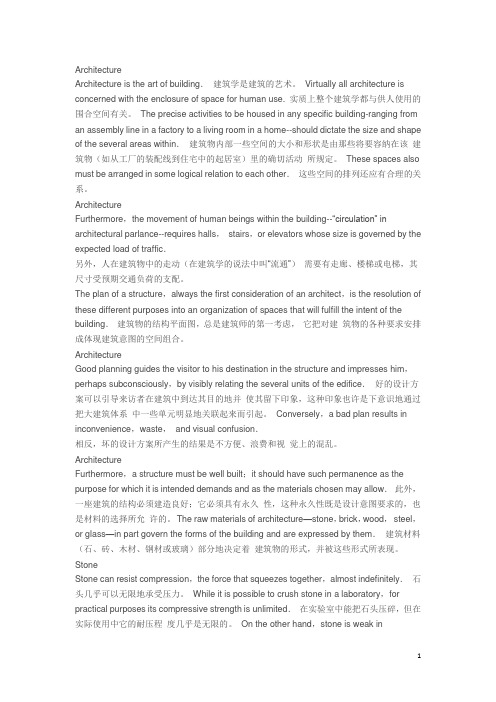
ArchitectureArchitecture is the art of building.建筑学是建筑的艺术。
Virtually all architecture is concerned with the enclosure of space for human use. 实质上整个建筑学都与供人使用的围合空间有关。
The precise activities to be housed in any specific building-ranging from an assembly line in a factory to a living room in a home--should dictate the size and shape of the several areas within.建筑物内部一些空间的大小和形状是由那些将要容纳在该建筑物(如从工厂的装配线到住宅中的起居室)里的确切活动所规定。
These spaces also must be arranged in some logical relation to each other.这些空间的排列还应有合理的关系。
ArchitectureFurthermore,the movement of human beings within the building--“circulation” in architectural parlance--requires halls,stairs,or elevators whose size is governed by the expected load of traffic.另外,人在建筑物中的走动(在建筑学的说法中叫“流通”)需要有走廊、楼梯或电梯,其尺寸受预期交通负荷的支配。
The plan of a structure,always the first consideration of an architect,is the resolution of these different purposes into an organization of spaces that will fulfill the intent of the building.建筑物的结构平面图,总是建筑师的第一考虑,它把对建筑物的各种要求安排成体现建筑意图的空间组合。
托福阅读 TPO03 第1篇 Architecture
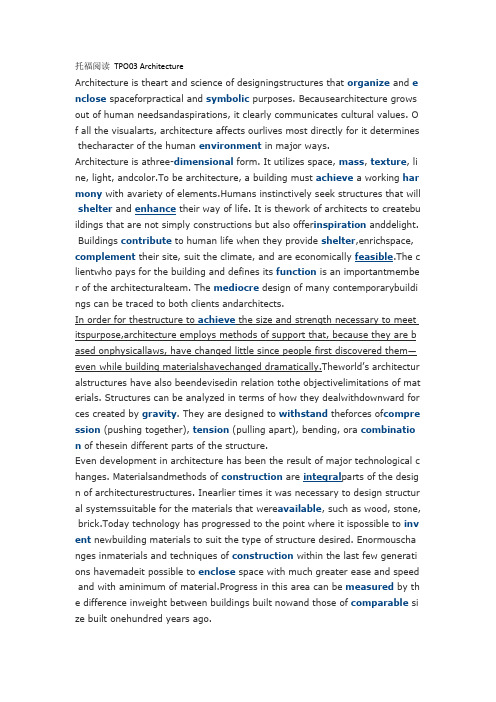
托福阅读TPO03 ArchitectureArchitecture is theart and science of designingstructures that organize and e nclose spaceforpractical and symbolic purposes. Becausearchitecture grows out of human needsandaspirations, it clearly communicates cultural values. O f all the visualarts, architecture affects ourlives most directly for it determines thecharacter of the human environment in major ways.Architecture is athree-dimensional form. It utilizes space, mass, texture, li ne, light, andcolor.To be architecture, a building must achieve a working har mony with avariety of elements.Humans instinctively seek structures that will shelter and enhance their way of life. It is thework of architects to createbu ildings that are not simply constructions but also offer inspiration anddelight. Buildings contribute to human life when they provide shelter,enrichspace, complement their site, suit the climate, and are economically feasible.The c lientwho pays for the building and defines its function is an importantmembe r of the architecturalteam. The mediocre design of many contemporarybuildi ngs can be traced to both clients andarchitects.In order for thestructure to achieve the size and strength necessary to meet itspurpose,architecture employs methods of support that, because they are b ased onphysicallaws, have changed little since people first discovered them—even while building materialshavechanged dramatically.Theworld’s architectur alstructures have also beendevisedin relation tothe objectivelimitations of mat erials. Structures can be analyzed in terms of how they dealwithdownward for ces created by gravity. They are designed to withstand theforces of compre ssion (pushing together), tension (pulling apart), bending, ora combinatio n of thesein different parts of the structure.Even development in architecture has been the result of major technological c hanges. Materialsandmethods of construction are integral parts of the desig n of architecturestructures. Inearlier times it was necessary to design structur al systemssuitable for the materials that were available, such as wood, stone, brick.Today technology has progressed to the point where it ispossible to inv ent newbuilding materials to suit the type of structure desired. Enormouscha nges inmaterials and techniques of construction within the last few generati ons havemadeit possible to enclose space with much greater ease and speed and with aminimum of material.Progress in this area can be measured by th e difference inweight between buildings built nowand those of comparable si ze built onehundred years ago.Modernarchitectural forms generally have three separate components comp arable toelementsof the human body: a supporting skeleton or frame, an o uter skinenclosing the interiorspaces, and equipment, similar to the body’s vit al organs and systems. Theequipment includes plumbing, electrical wiring, h ot water, andair-conditioning. Of course in early architecture—suchas igloos a nd adobe structures—there was no suchequipment, and the skeleton andskin were often one.Much of the world’s great architecture has beenconstructed of stone because of its beauty,permanence, and availability. Inthe past, whole cities grew fro m thearduoustask of cutting andpilingstone upon. Some of the world’s finest s tonearchitecture can be seen in the ruins of theancient Inca city of Machu Picc huhigh in the eastern Andes Mountains of Peru. Thedoorwaysandwindowsare made possible by placing over the open spaces thick stone beamsthat support the weight from above. A structural invention had to be madebefore the phy sical limitations ofstone could be overcome and newarchitectural forms could be created. That invention was the arch, a curvedstructure originally made of separate stone or brick segments. The arch wasused by the early cultures of the Mediterranean area chiefly for undergrounddrains, but itwas the Roman s who first developed and used the arch extensivelyin aboveground structure s.Roman builders perfected the semicircular arch madeof separate blocks of stone. As a methodof spanning space, the arch cansupport greater weight th an a horizontal beam. It works in compression todivert the weight above it out to the sides, where the weight is borne bythevertical elements on either side of the arch. The arch is among the manyimportantstructural breakthrou ghs that have characterized architecturethroughout the centuries.1. According toparagraph 1, all of the followingstatements about arch itecture are true EXCEPT:A.Architecture isvisual art.B.Architecturereflects the cultural values of its creators.C.Architecture hasboth artistic and scientific dimensions.D.Architecture hasan indirect effect on life.2. The word “feasible”in the passage (paragraph 2) is closest in mean ing toA.in existenceB.without questionC.achievableD.most likely3. The word “enhance”in the passage (paragraph 2) is closest in mea ning toA.protectB.improveanizeD.match4. Which of thesentences below best expresses the essential informat ion inthehighlightedsentencein the passage (paragragh 3) ? Incorrect choices changethemeaning in important ways or leave out essential i nformation.A.Unchangingphysical laws have limited the size and strength of buildings th at can be madewithmaterials discovered long ago.B.Buildingmaterials have changed in order to increase architectural size and s trength,butphysical laws of structure have not changed.C.When people firststarted to build, the structural methods used to provide st rength and sizewereinadequate because they were not based on physical laws .D.Unlike buildingmaterials, the methods of support used in architecture have not changedovertime because they are based on physical laws.5. The word “devised”in the passage (paragragh 3) is closest in mean ing tobinedB.createdC.introducedD.suggested6. The word “integral”(paragraph 4) is closest in meaning toA.essentialB.variableC.practicalD.independent7. According toparagraph 4, which of the following is true about mate rialsused intheconstruction of buildings?A.Because newbuilding materials are hard to find, construction techniques h ave changedverylittle from past generations.B.The availabilityof suitable building materials no longer limits the types of st ructures thatmaybe built.C.The primarybuilding materials that are available today are wood, stone, an d brick.D.Architects inearlier times did not have enough building materials to enclose large spaces.8. In paragraph 4,what does the author imply about modern buildings ?A.They occupy muchless space than buildings constructed one hundred yea rs ago.B.They are not verydifferent from the building of a few generations ago.C.They weigh lessin relation to their size than buildings constructed one hun dred years ago.D.They take a longtime to build as a result of their complex construction m ethods.9. Which of thefollowing correctly characterizes the relationship betw een the humanbody andarchitecture that is described in paragraph 5?plex equipmentinside buildings is the one element in modern architect ure that resemblesacomponent of the human body.B.The components inearly buildings were similar to three particular elements of the humanbody.C.Modern buildingshave components that are as likely to change as the huma n body is.D.In general,modern buildings more closely resemble the human body than earlier buildingsdo.10. The word “arduous”in the passage (paragraph 6) is closest in me aning toA.difficultB.necessaryC.skilledD.shared11. Why does theauthor include a description of how the “doorways a ndwindows”(paragraph 6) ofMachu Picchu were constructed?A.To indicate thatthe combined skeletons and skins of the stone buildings of Machu Picchuweresimilar to igloos and adobe structuresB.To indicate thedifferent kinds of stones that had to be cut to build Machu P icchuC.To provide anillustration of the kind of construction that was required befo re archeswereinventedD.To explain howancient builders reduced the amount of time necessary to co nstruct buildingsfrom stone12. According toparagraph 6, which of the following statements is true ofthe arch?A.The Romans werethe first people to use the stone arch.B.The invention ofthe arch allowed new architectural forms to be developed.C.The arch workedby distributing the structural load of a building toward the center of thearch.D.The Romansfollowed earlier practices in their use of arches.13. Look at thefour squares [█] that indicate wherethe following sent ence could beadded to the passage.█【A】Modern architectural forms generally have three separate componentscompa rable toelements of the human body; a supporting skeleton or frame, anout er skin enclosing theinterior spaces, and equipment, similar to the body’s vita l organs and systems. █【B】Theequipment includes plumbing, electrical wiring, hot water, andair-conditi oning. █【C】Ofcoursein early architecture—such as igloos and adobestructures—there was no such equipment, andtheskeleton and skin were often one. █【D】Where would thesentence best fit?14. Directions: Anintroductory sentence for a brief summary of the pa ssage is plete the summary by selecting the THRE E answer choices that expressthemost important ideas in the passage . Some sentences do not belong in thesummarybecause they express i deas that are not presented in the passage or areminor ideas inthe pa ssage. This question is worth 2 points.Architecture usesforms and space to express cultural values.A.Architects seekto create buildings that are both visually appealing and well suited forhumanuse.B.Over the courseof the history of building, innovations in material and metho ds ofconstructionhave given architects ever greater freedom to express thems elves.C.Throughouthistory buildings have been constructed like human bodies, ne eding distinct“organ”systems inorder to function.D.Both clients andarchitects are responsible for the mediocre designs of som e modernbuildings.E.Modern buildingstend to lack the beauty of ancient stone buildings such as t hose ofMachuPicchu.F.The discovery anduse of the arch typifies the way in which architecture adv ances bydevelopingmore efficient types of structures.1.EXCEPT题排除法,以visual art做关键词定位至本段最后一句,A对,不选;以cultural values做关键词定位至第二句,B对,不选;以artistic and scientific dimensions做关键词定位至第一句,C对,不选;D选项与A 选项在同一句,indirect effect和directly的原文说反,错,选2.feasible可行的,原文说了建筑的若干优点,比如提供遮风避雨的场所,丰富了空间,经济上怎么样,肯定是个正面的词,A存在中性,错;B没有问题,虽然是正面但太过,不选,C正确,D非常可能虽然正面,但程度不足,不选3.词汇题,问的是第二段第三句中的enhance,备选项分别是protect, improve, organize,match,enhance提高,原文中与enhance their way of life并列的动词是shelter,庇护之意,所以再选protect的话重叠,而且也不应该是保护他们的生活方式;organize组织match搭配都不能与庇护并列,所以improve改善生活方式最靠谱4.In order for只是一个表目的的状语,暂时放弃不看,同时because那部分插入语不看,整个句子就变成了建筑师们采用的方法是不变的,尽管建筑材料发生了很大变化。
architecture 建筑
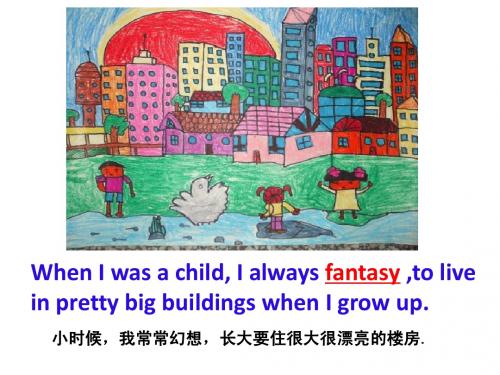
Open architectural appearance is lightsome Seems to visitors on invitation. [,invi'teiʃən]
开放状的建筑外形轻盈而飘逸,似乎 在向参观者们发出真挚的邀请。
What is this building?
The building of a country, a
s]
澳大利亚馆宛如澳大利亚 内陆的红土.
As the Australian outback museum display of clay. Australia‘s theme of “rock bed (岩床)". "Rock bed" is the traditional and modern art in Australia's unique form.
Cherish all around,be self-confidence, You also attract people.
珍惜身边的一切,对自己有自信,你也一样吸引人,成为万众瞩目的焦点
city is represents a unique architectural culture.
一个国家,一个城市的建筑是 代表着一份独特的建筑文化。
The unique architectural culture to the whole country adds color.
独特的建筑文化为整个国家增添了的色彩.
长大以后,我爱上了旅游, 欣赏独特的建筑文化.
• • • • • • • •
fantasy architectural traditional timberwork development element Denmark lightsome
architecture 怎么读

architecture 怎么读
“Architecture”是一个英语单词,发音为英式音标/ˈɑːkɪtekt ʃə(r)/ 和美式音标/ˈɑːrkɪtektʃər/。
这个单词的发音可以拆分为两个音节:“arch-”和“-itecture”,并在“arch-”上放置重音。
在发音时,注意保持整个单词的音调平稳,并确保清晰地发出每个音节。
“Architecture”的基本含义是“建筑学”或“建筑式样”,它涉及建筑物的设计、构造、风格和外观等方面。
这个单词通常用于描述建筑物的整体结构和外观设计,也可以指建筑艺术的风格和流派。
此外,“Architecture”还可以引申为“体系结构”或“组织结构”的意思,用于描述系统、机器、软件或组织的内部结构和构成方式。
这种用法通常用于技术、工程或管理领域。
总之,“Architecture”是一个具有描述性和专业性的名词,用于表示建筑学、建筑式样、体系结构或组织结构等概念。
在发音时,注意将重音放在正确的音节上,并保持清晰的发音。
同时,在使用时也需要注意具体语境和语法规则,以确保表达的准确性和清晰度。
此外,由于“Architecture”是一个较为专业的词汇,因此在不同的领域和语境中可能会有不同的含义和用法,需要根据具体情况进行理解和运用。
建筑名词大全

建筑名词大全建筑是人类的重要创造,而建筑行业拥有许多专业术语和名词。
在本文中,我将为您介绍一些常用的建筑名词,以帮助您更好地理解和熟悉建筑领域。
一、土建工程1. 地基基础(Foundation):建筑物的基础部分,用于支撑整个建筑结构。
2. 桩基(Pile Foundation):通过往地下打入桩来提供更好的承载力和稳定性。
3. 柱子(Column):垂直支持建筑物的结构元件。
4. 梁(Beam):连接柱子或墙体,承受和传递荷载的水平结构元件。
5. 楼板(Floor Slab):楼层间的水平面,承载人员和物品。
6. 砌体墙(Masonry Wall):由砖、石等材料砌筑而成的墙体。
7. 钢筋混凝土(Reinforced Concrete):一种由钢筋和混凝土组成的复合材料,具有较高的强度和耐久性。
8. 屋顶(Roof):建筑物的顶部覆盖结构。
9. 抗震设计(Seismic Design):建筑物抵御地震力量的设计。
二、建筑构件1. 窗户(Window):建筑物外墙上的开口,用于采光和通风。
2. 门(Door):建筑物的主要出入口。
3. 楼梯(Staircase):连接不同楼层的结构,供人上下。
4. 扶手(Handrail):楼梯或走廊旁边的支撑结构,用于提供支撑和保护。
5. 地砖(Floor Tile):用于覆盖地板的瓷砖或其他材料。
6. 吊顶(Ceiling):覆盖在房间顶部的结构,通常隐藏电气线路和其他设备。
7. 墙纸(Wallpaper):用于装饰和覆盖墙面的材料。
8. 瓷砖(Tiles):用于墙面和地面的陶瓷砖。
9. 管道(Pipe):用于输送水、气体、电力等的管状结构。
三、建筑风格1. 古典建筑(Classical Architecture):受古希腊和古罗马建筑风格影响的建筑风格。
2. 现代主义建筑(Modernist Architecture):强调功能和简约的建筑风格。
3. 后现代主义建筑(Postmodernist Architecture):突破传统限制,强调个性和多样性的建筑风格。
建筑风格介绍【英文】

Architectural Style
Architectural style is a way of classifying architecture largely by morphological characteristics:
Form Techniques Materials
May refer to a building style of a particular culture or to an artistic movement such as Greek, Gothic, and Renaissance architecture.
What is Architecture?
Temple of Ramesses II
Neoclassical Architecture 新古典主义建筑
Neoclassical style produced by the neoclassical movement during the 18th century. Neoclassical, or "new" classical, architecture describes buildings that are inspired by the classical architecture of ancient Greece and Rome.
Stonehenge
Egyptian Architecture 古埃及建筑
Due to lack of wood most Egyptian architecture was made with mud-brick and stone. Minerals included sandstone, limestone, and granite, which were generally used for tombs and temples. Most ancient Egyptian towns have been lost because they were situated in the cultivated and flooded area of the Nile Valley.
我们知道建筑architecture,是一个外来的词,在牛津字典里面

《中华人民共和国学位条例》对授予博士学位的要求是:
(一)在本门学科上掌握坚实宽广的基础理论和系统深入的专门 知识;(“本门学科”是指一级学科吗?是原来的建筑学一级学科,还是
现在的三个一级学科中的一个?“广义建筑学”还成立吗?)
(二)具有独立从事科学研究工作的能力; (三)在科学或专门技术上做出创造性的成果。 从这三条要求来看,中国的博士与美国的Ph.D大致相当,属于
研究性学位。
但美国还有一种Professional Doctor,例如在医学,8年的大学学习, 可以获得Doctor of Medical,这是专业性学位,可以当临床医生,但不是 做医学研究的Ph.D。艺术方面也类似,Doctor of Music Art 是Professional 学位,要进行声乐训练,要舞台演出,而Ph.D in Music Art 是研究性学 位,进行音乐艺术研究,没有演出要求。 哈佛大学建筑学有两种博士学位,一个是PhD,另外一个是,D Des Doctor of Design,这是一个professional的学位,不是PhD,PhD in Architecture要念六到七年,D Des是四年。哈佛有关建筑学的PhD program主要是在Art and Science文理学院。但在中国不分PhD与Doctor of Design,都叫博士。但是实际上很多博士生在那儿做工程,将来要到 设计单位去工作,而且我们也没有像哈佛那样花七年的时间,所以好像 是Doctor of Design。尤其是建筑设计与理论的博士点,13个博士点学校 个个都有,而且学生也比较多,真要做理论研究,选题其实是挺困难的。 如果我们能够区分一下PhD和Doctor of Design,事情就好办了。这是值 得研究的问题。但美国有Professional Doctor 的建筑院系很少,只有哈佛等一
架构的源起
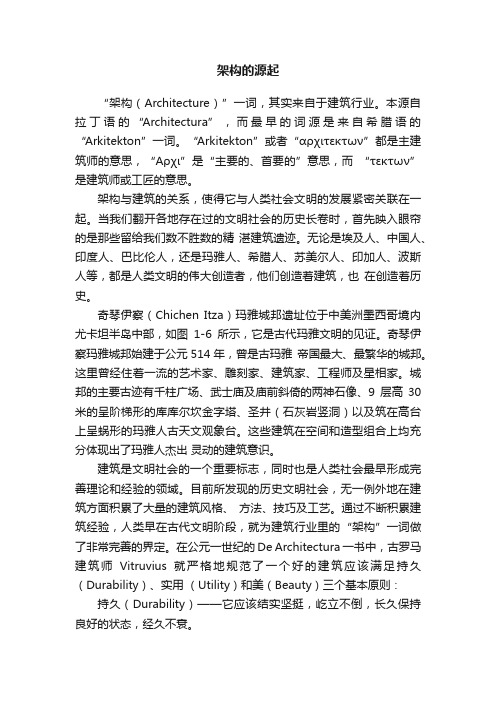
架构的源起“架构(Architecture)”一词,其实来自于建筑行业。
本源自拉丁语的“Architectura”,而最早的词源是来自希腊语的“Arkitekton”一词。
“Arkitekton”或者“αρχιτεκτων”都是主建筑师的意思,“Αρχι”是“主要的、首要的”意思,而“τεκτων”是建筑师或工匠的意思。
架构与建筑的关系,使得它与人类社会文明的发展紧密关联在一起。
当我们翻开各地存在过的文明社会的历史长卷时,首先映入眼帘的是那些留给我们数不胜数的精湛建筑遗迹。
无论是埃及人、中国人、印度人、巴比伦人,还是玛雅人、希腊人、苏美尔人、印加人、波斯人等,都是人类文明的伟大创造者,他们创造着建筑,也在创造着历史。
奇琴伊察(Chichen Itza)玛雅城邦遗址位于中美洲墨西哥境内尤卡坦半岛中部,如图1-6所示,它是古代玛雅文明的见证。
奇琴伊察玛雅城邦始建于公元514年,曾是古玛雅帝国最大、最繁华的城邦。
这里曾经住着一流的艺术家、雕刻家、建筑家、工程师及星相家。
城邦的主要古迹有千柱广场、武士庙及庙前斜倚的两神石像、9层高30米的呈阶梯形的库库尔坎金字塔、圣井(石灰岩竖洞)以及筑在高台上呈蜗形的玛雅人古天文观象台。
这些建筑在空间和造型组合上均充分体现出了玛雅人杰出灵动的建筑意识。
建筑是文明社会的一个重要标志,同时也是人类社会最早形成完善理论和经验的领域。
目前所发现的历史文明社会,无一例外地在建筑方面积累了大量的建筑风格、方法、技巧及工艺。
通过不断积累建筑经验,人类早在古代文明阶段,就为建筑行业里的“架构”一词做了非常完善的界定。
在公元一世纪的De Architectura一书中,古罗马建筑师Vitruvius就严格地规范了一个好的建筑应该满足持久(Durability)、实用(Utility)和美(Beauty)三个基本原则:持久(Durability)——它应该结实坚挺,屹立不倒,长久保持良好的状态,经久不衰。
- 1、下载文档前请自行甄别文档内容的完整性,平台不提供额外的编辑、内容补充、找答案等附加服务。
- 2、"仅部分预览"的文档,不可在线预览部分如存在完整性等问题,可反馈申请退款(可完整预览的文档不适用该条件!)。
- 3、如文档侵犯您的权益,请联系客服反馈,我们会尽快为您处理(人工客服工作时间:9:00-18:30)。
Design Implications
• Goal: survivability against failures ◦ In the event of failure, the ongoing communications should resume from the point of failure after “re-configuration” → Maintain “state information” that should not be lost • Implication: ◦ Network is heterogeneous → Maintain “state information” at the end host that are communicating − that is, a state-free network • An example of state maintained as end-hosts ◦ Connection information and packet numbers
6.976/ESБайду номын сангаас.937 2
An Example
• Consider the example of Telephone network • Here is list of desired properties/utilities and their implications ◦ Functionality: allow for real-time voice communication → need a very fast communication technology ◦ Privacy: conversation should be private → communication should be encrypted or should happen over secure links ◦ Accountability: resources utilized must be accountable ◦ Pricing: cost must be proportional to usage → basic communication unit should be a phone call ◦ Economical: system must be affordable ◦ Scalability: should be able to accommodate growing demand ◦ Robustness: must operate even when few components fail ...
6.976/ESD.937 7
Design Implications
• Next, we study the design implications of these goals • The most important design goal is to allow ◦ Multiplexing between hetergeneous independent networks → packet switching architecture, where data is communicated into independent units called data-grams ◦ Subsequently, networks must be interconnected via packet switches or gateways. • In summary, structure of Internet should be such that ◦ Packet-switched commication between heterogeneous networks ◦ Different networks are connected via packet communication processors, called gateways − which implement store and forward packet routing algorithms • Now, the other goals
6.976/ESD.937 3
Other Examples
• Engineered systems ◦ Airline system − Primary purpose: safe, efficient and economical commuting → Implications: regulations on checking of planes, design of optimized routes and schedules, inventory control, human resource, etc. ◦ Energy distribution system − Primary purpose: efficient, ubiquitous and economical energy distribution → Implications: design of optimized power-grid, set up of energy exchanges or markets, placement of energy plants, regulations on pricing energy resource etc.
6.976/ESD.937
4
Internet
• Next, we will study the design of Internet in detail
• We will talk about ◦ A brief history of Internet ◦ The utility or goals of Internet − initial goals → their implications and current design ◦ Current challenges or new goals − network security, etc.
System Architecture
• Topics: ◦ Design Philosophy − how to go about thinking of architecture? − or, what drives the architecture design? − some examples ◦ Internet architecture − history and evolution − current design: modular architecture − new challanges: security, ... ◦ Interplay between theory & architecture design − digital communication and information theory − parallel programming and von Neumann bridge
6.976/ESD.937
1
Architecture
• Webster interpretation ◦ Architecture = the art or science of building (system) • A system design philosophy ◦ List desired goals, properties, functional utility of the system in the order of importance ◦ Derive design implications of the desired goals/properties/utility of system ◦ Search for means/methods/technology for designing appropriate architecture ◦ Repeat the above steps until one finds feasible, economical architecture that performs as desired → This philosophy leads to ”an art of building system” ◦ Next, we see some examples
6.976/ESD.937
5
Brief History of Internet
• The original Internet project was started in the late 1970s ◦ It was a DARPA funded project known as ARPANET • Motivations behind the ARPANET project ◦ To develop an effective architecture for multiplexed utilization of − existing interconnected, heterogeneous, independent and possible unreliable networks ◦ Specifically, allow for access of ARPANET server − to field agent via ARPA radio network • The Internet or ARPANET ◦ Could have been custom designed for the above purpose ◦ But, fortunately that was not the case − allowing for a general purpose network design • Next, we see goals considered by the architects of ARPANET or Internet
